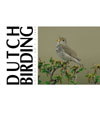Dutch Birding volume 27 (2005) no 5

Crested Ibis
'Toki' is the Japanese name for Crested Ibis Nipponia nippon. In the past, this magnificent bird could be seen in most parts of Japan but due to excessive hunting and environmental pollution in the early 20th century numbers plunged until only few remained. In 1952, the species was designated a 'Special Natural Monument' and, in 1960, it was listed as an internationally protected species (cf Stattersfield & Capper 2000). On Sado island in Niigata prefecture, the last breeding site in Japan, numbers dropped from 27 in 1941, 24 in 1952 to 11 in 1957 and the last wild bird was taken in captivity in 1981. Efforts with captive breeding at the Toki Preservation Centre on Sado, established in 1967, have not been successful. In 1986, only two birds survived in captivity on Sado (Brazil 1991). Midori, the sole surviving native male, died in April 1995. The last Japanese bird, a female named Kin taken in captivity in 1968 just one year old, died on 10 October 2003 at the age of 36.
The species - which once occurred in large parts of eastern and central China, in Amurland, Siberia, Russia, in North and South Korea, in most of Japan north to southern Hokkaido and in Taiwan - was believed to have become globally extinct but in 1981 it was confirmed that seven individuals were still surviving in Shaanxi province, China. These birds where found in an area as large as Belgium. Japan and China have since then been working closely to conserve the species. For example, Japan received a Chinese male on loan in 1985 for captive breeding (without success, however), in exchange for the training of Chinese breeding experts and the provision of equipment and materials for China. A pair was flown in from China to Sado in 1994 in an attempt to breed them with the last two Japanese birds but this also failed. The third exchange was finally successful: in 1999, China gave Japan a pair named Youyou and Yangyang. They became the parents of Yuuyuu, Japan's first chick hatched by artificial incubation, causing great celebration throughout Japan. Two more chicks hatched in 2000, then 11 more, from two pairs, in 2001. In September 2002, the population at the Toki Preservation Centre had risen to 25. The next step will be to develop a natural environment for them in the wild. However, many problems must be solved before the birds can be returned to the wild, including protecting them from natural enemies like marten and crows, developing feeding grounds, and getting them ready to tend for themselves (Kuniko 2002).
China opened up for foreign travellers in 1983. From that year on, it became possible to go birding in this huge country. Nowadays, birders have more and more freedom and, with a local guide, can visit most places they want. Because of this, the true status of birds breeding in China has become clearer than it was before which resulted in many (re)discoveries of previously undescribed taxa or species feared extinct. Unfortunately, it also became clear that many species are on the verge of extinction. During a Birdquest tour in May 2005, I was able to visit an area called Yangxiang in Shaanxi province, about a day's drive south-west of Xi'an (an expressway is being built so in the near future it will take only a couple of hours to reach). During this visit, local people working with the ibises informed me that the total population in China now stands at more than 400 birds, with an additional c 100 in captivity. At the place visited, 24 birds were present during this breeding season. Three nests were known of which one, near a little village called Caoba, was visited; it contained two young still being fed. In this time of year, adult are in silvery grey breeding plumage, most greyish on head, neck and mantle, with a pink flush on the whiter parts. In the non-breeding season, they are almost completely white with a pink flush. The bare facial skin, iris and legs are red in adults; the two young showed a dark iris and deep yellow facial skin and legs. In winter, c 120 birds can be seen at the communal roosts in this area. The birds are quite shy but are breeding at the edge of villages, making high crying calls when they leave the roost or the nest.
Captive breeding in China has been very successful. There are now three breeding centres in this part of China, all near the natural colonies where breeding is going on. Captive-born birds are released three years after hatching. In the field, these bird seem to mix easily with the wild birds giving the 'wild' population an extra impulse. During my visit, I saw ringed (in many different ways) and unringed birds mixing and even unringed ones paired with ringed ones.
The main threat for this species seems to be starvation in the winter months because of the absence of accessible rice-fields. Artificial wet rice-fields offering food and where agrochemicals are not being used are created, and nesting sites are patrolled by the people working for the conservation of this species in China.
Max Berlijn, Wilhelminastraat 9, 6285 AS Epen, Netherlands (max.berlijnnn.nl)
terug






